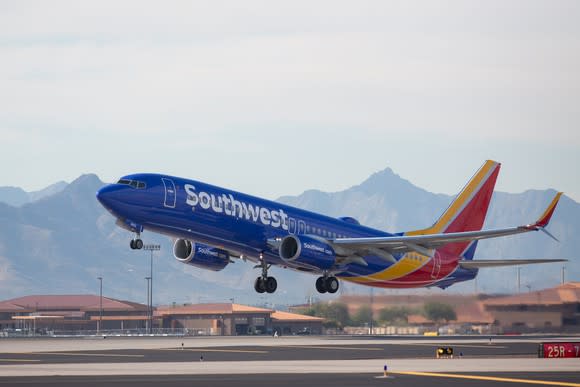Hawaiian Holdings Stock Craters Again on the Latest Southwest Airlines News
Last December, shares of Hawaiian Holdings (NASDAQ: HA) hit an all-time high above $60, up from less than $6 as recently as 2013.
Since then, the Hawaiian Airlines parent has delivered a string of solid earnings reports. Yet investors have become increasingly worried about an uptick in competition that's coming in 2018. United Continental will increase its capacity to Hawaii significantly starting just before the end of this year, while Southwest Airlines (NYSE: LUV) hopes to start flying to Hawaii next year. As a result, Hawaiian Holdings stock has been in freefall.
Hawaiian Holdings Stock Performance, data by YCharts.
On Thursday, Hawaiian Holdings shares plunged another 6% -- this time over fears that Southwest will enter the Hawaii inter-island market in addition to flying between the West Coast and Hawaii. This sell-off represents a great buying opportunity for long-term investors.
Hawaiian Airlines has the tools to win in the West Coast market
As I have noted previously, investors are underestimating Hawaiian Airlines' ability to fight back and win in the face of rising competition in the West Coast-Hawaii market, which accounts for about half of its revenue.
First, Hawaiian Airlines will soon finish retrofitting the last of its A330s with lie-flat seats in first class. None of its competitors offer an equivalent luxury product on West Coast-Hawaii flights.
Second, by late 2018, more than 30% of the seats in Hawaiian's fleet for West Coast-Hawaii flights will be in first class or the extra-legroom economy section. By contrast, Southwest Airlines doesn't have a dedicated extra-legroom offering.
Third, Hawaiian Airlines' new A321neo fleet will allow the carrier to more precisely match capacity to demand in its West Coast markets.
Despite these tools, Hawaiian Airlines' unit revenue will surely decline on some routes as competition ramps up. That's just a natural part of the supply-demand balance. Nevertheless, Hawaiian Airlines should be able to continue earning solid margins in those markets.

Hawaiian Airlines has big competitive advantages for West Coast-Hawaii flights. Image source: Hawaiian Airlines.
An even bigger threat?
The reason behind the most recent swoon in Hawaiian Holdings stock was a question about inter-island service that came up on Southwest Airlines' earnings call.
Airline analyst Jamie Baker asked management if it would be feasible to operate inter-island flights in Hawaii. CEO Gary Kelly responded that there were no operational constraints that would prevent Southwest from doing so. Kelly went on to say that flying between the islands isn't a top priority, but is something the company would consider at some point.
Based on this exchange, it's clear that Southwest Airlines has no firm plans to fly inter-island routes in the near future. However, if Southwest did enter this market, that would represent a much bigger threat to Hawaiian Airlines than the carrier's upcoming launch in the West Coast-Hawaii market.
Whereas Hawaiian already faces robust competition on most of its West Coast routes, it has roughly 90% market share in Hawaii. Furthermore, Southwest's cost advantages are most potent on short-haul routes. That could set the stage for a powerful "Southwest Effect" -- big declines in fares accompanied by a surge in traffic -- within the inter-island market.
Hawaiian Airlines has time
Concerns about growth by United and Southwest in the West Coast-Hawaii market will probably turn out to be much ado about nothing. By contrast, the prospect of having Southwest Airlines enter the inter-island market is a legitimate threat to Hawaiian Airlines. The carrier hasn't faced a serious competitor in its home market since Aloha Airlines went out of business in early 2008.
That said, Hawaiian Holdings stock currently trades for just six times the company's estimated 2017 earnings. Investors are already pricing in a significant decline in Hawaiian's profit margin.
Furthermore, Hawaiian Airlines will have time to meet the threats it faces and adjust to them. It will probably take until late 2018 for Southwest Airlines to launch its first Hawaii flights, because of various regulatory hurdles. Starting an inter-island operation would have to wait until even later. And Southwest has numerous competing expansion opportunities, which will limit the pace of its growth in Hawaii.

Southwest Airlines could eventually fly between the Hawaiian islands. Image source: Southwest Airlines.
Even in the inter-island market, Hawaiian Airlines would be in a strong position to respond to Southwest's growth. Most of its inter-island fleet of Boeing 717 jets will be fully paid off within two years. That will give Hawaiian the flexibility to protect its profitability by downsizing its inter-island operation or by replacing its 717s with newer jets to improve its cost structure if necessary.
In short, it's true that Hawaiian Airlines could face some profit pressure because of rising competition in the next few years. However, investors have overreacted to this threat. With Hawaiian Holdings stock trading at a bargain valuation, this could be a great time to buy.
More From The Motley Fool
Why You're Smart to Buy Shopify Inc. (US) -- Despite Citron's Report
6 Years Later, 6 Charts That Show How Far Apple, Inc. Has Come Since Steve Jobs' Passing
Adam Levine-Weinberg owns shares of Hawaiian Holdings. The Motley Fool has no position in any of the stocks mentioned. The Motley Fool has a disclosure policy.

 Yahoo Finance
Yahoo Finance 
